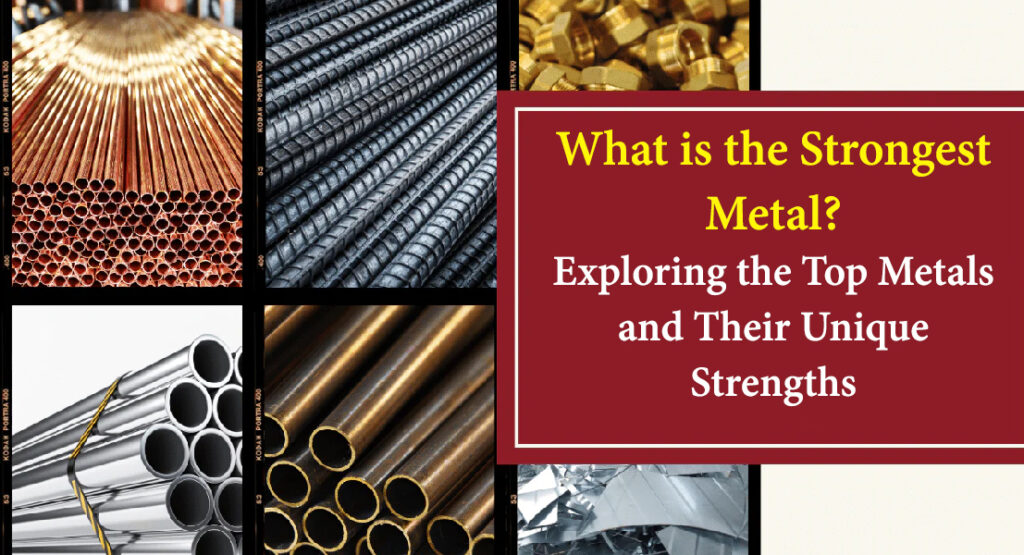The concept of the “strongest metal” depends on how we measure strength. Metals vary in properties like tensile strength, hardness, yield strength, and compressive strength. Each metal has unique qualities that make it suitable for specific applications. While one metal might excel in tensile strength, another may be the hardest or most resilient to wear. This article explores the metals most commonly regarded as the strongest in their categories, including tungsten, titanium, chromium, and steel alloys. Let’s explore in detail about what is the strongest metal.

Defining Metal Strength
To understand which metal is the strongest, it’s important to know how strength is measured. Different factors contribute to a metal’s strength, and they are often measured in distinct ways:
- Tensile Strength: This is the metal’s resistance to being pulled apart. It’s critical in applications where metals undergo stretching or pulling.
- Hardness: This measures a metal’s resistance to scratching, indentation, or deformation. Harder metals are more resistant to wear and tear.
- Yield Strength: Yield strength determines the point at which a metal will bend or deform under pressure.
- Compressive Strength: This measures the ability of a metal to withstand squeezing or compression forces.
Each of these factors contributes to what makes a metal “strong,” but no single metal dominates all categories. Let’s explore the metals that stand out in each category.
1. Tungsten – The Metal with the Highest Tensile Strength
Tungsten is often regarded as the metal with the highest tensile strength. This means it can withstand pulling forces without breaking. With a tensile strength of approximately 1510 megapascals (MPa), tungsten resists bending and breaking under tension better than most metals.
Why is Tungsten So Strong?
Tungsten’s strength comes from its atomic structure and the way its atoms bond. Its high melting point, around 3,422°C (6,192°F), also contributes to its ability to maintain strength at high temperatures. This makes tungsten ideal for uses that require intense heat resistance, like in aerospace and military applications.
Uses of Tungsten
Due to its high tensile strength, tungsten is commonly used in applications where durability under extreme conditions is essential. Tungsten is found in military armor, industrial machinery, rocket engine nozzles, and electrodes in welding. However, because it’s brittle, tungsten isn’t ideal for all purposes, especially those requiring flexibility.
2. Titanium – Known for Its High Strength-to-Weight Ratio
Titanium is famous for its combination of strength and low density. Although it doesn’t have the absolute highest strength, its strength-to-weight ratio is exceptional. Titanium’s tensile strength is around 434 MPa, which is impressive given its lightweight nature.
Why is Titanium Special?
Titanium’s unique qualities come from its crystalline structure, which is strong yet relatively flexible. It resists corrosion remarkably well, making it ideal for environments exposed to moisture or chemicals. Additionally, it’s biocompatible, meaning it’s safe for human use, which is why it’s popular in medical implants.
Uses of Titanium
Titanium’s lightweight strength makes it invaluable in the aerospace, automotive, and medical industries. It’s commonly used in aircraft frames, racing car components, and even in medical implants like hip and knee replacements. Titanium’s resistance to saltwater corrosion also makes it popular in marine equipment.
3. Chromium – The Hardest Metal on the Mohs Scale
When it comes to hardness, chromium tops the list. This metal ranks 9 on the Mohs hardness scale, making it one of the hardest elements in existence. Chromium’s high hardness gives it excellent wear resistance, making it ideal for protective coatings.
Why is Chromium Hard?
Chromium’s atomic structure creates tightly bonded layers that resist scratching and abrasion. Its high hardness also means it has a bright, shiny finish and resists corrosion, which is why it’s commonly useful to plate other metals.
Uses of Chromium
Chromium is most commonly useful as a plating material on other metals, such as in chrome-plated steel or nickel. It’s also a critical component in stainless steel, where it provides corrosion resistance. The automotive industry uses chromium extensively for vehicle parts to improve durability and visual appeal.
4. Steel Alloys – The Versatile Strength of Alloyed Metals
Steel, particularly when alloyed with other metals, exhibits impressive strength in various forms. Some steel alloys like high-carbon steel, tool steel, and maraging steel have higher strengths than most pure metals. Alloying steel with elements like carbon, nickel, or manganese increases its yield strength, compressive strength, and hardness.
Why are Steel Alloys Strong?
The strength of steel alloys comes from the combination of iron with other metals or carbon. This alloying process creates a tightly bonded crystal structure, giving the metal increased durability and resilience. Maraging steel, for example, has a yield strength of around 2,000 MPa, making it one of the strongest steel alloys.
Uses of Steel Alloys
Steel alloys are the backbone of construction, automotive manufacturing, and heavy machinery. High-carbon steel is often used in cutting tools, while stainless steel, with added chromium, is valued for its corrosion resistance in cookware, surgical instruments, and appliances. Maraging steel is also usefull in aerospace and defense applications due to its incredible strength.
5. Osmium – One of the Densest Metals
Osmium is also popular for its high density rather than tensile strength, but its extreme hardness and compressive strength make it noteworthy. It’s one of the rarest elements, and its density measures about 22.6 grams per cubic centimeter, making it the densest naturally occurring metal.
Why is Osmium Dense and Hard?
Osmium’s density and hardness are due to its atomic weight and tightly packed crystal structure. This gives it resistance to compression and high hardness, similar to chromium but without the widespread applications.
Uses of Osmium
Osmium’s high cost and rarity limit its uses, but it’s occasionally uses in alloys for fountain pen tips, electrical contacts, and in specialized scientific instruments. The metal’s extreme density makes it more suitable for niche applications rather than large-scale industrial use.
Comparing the Strengths of Different Metals
When evaluating these metals, it’s clear that each excels in specific areas of strength:
- Tensile Strength: Tungsten has the highest tensile strength, making it ideal for tension-based applications.
- Strength-to-Weight Ratio: Titanium wins for applications requiring lightweight strength.
- Hardness: Chromium stands out for hardness, giving it top wear resistance.
- Yield Strength and Versatility: Steel alloys, especially maraging and high-carbon steels, offer balanced strength and durability.
Why No Single Metal is “The Strongest”
The “strongest” metal depends on the type of strength needed for a particular application. No single metal ranks highest in all categories. For instance, while tungsten has the highest tensile strength, it’s brittle, making it unsuitable for applications that need flexibility. Titanium may be weaker than tungsten in tensile strength but is lighter and more corrosion-resistant, which makes it ideal for aerospace and medical uses.
Conclusion
Determining the strongest metal depends on how we define strength and the requirements of each specific application. Tungsten, titanium, chromium, steel alloys, and osmium each offer unique qualities that make them the strongest in their categories. Each has distinct properties, from tungsten’s unmatched tensile strength to titanium’s impressive strength-to-weight ratio. These metals are vital across multiple industries, highlighting how the concept of strength varies. As technology advances, alloys and composite materials continue to enhance the strengths of these metals, creating new possibilities for future applications.









